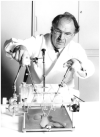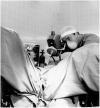The Development of Laparoscopy-A Historical Overview
- PMID: 34977146
- PMCID: PMC8714650
- DOI: 10.3389/fsurg.2021.799442
The Development of Laparoscopy-A Historical Overview
Abstract
The advent of laparoscopy marked a fundamental change in the evolution of medicine. The procedure progressed consistently after the first time it was performed in a human being nearly a hundred years ago. The 1960's and 1980's witnessed groundbreaking changes. During this time, laparoscopy evolved from a purely diagnostic procedure into an independent surgical approach. Outstanding pioneers of the times were Palmer, Frangenheim and Semm. Laparoscopy advanced rapidly and influenced gynecology as well. The procedure was initially attacked most vociferously by the surgical fraternity. However, within a short period of time the pendulum shifted: laparoscopy became the preferred surgical approach for a variety of diseases-whether benign or malignant-in several medical disciplines. Laparoscopy has become a routine approach in the twenty-first century. Technical advancements have led to robot-assisted surgery. Future developments will include artificial intelligence and augmented reality. In the present article we address past milestones, current practices, and future challenges in laparoscopy.
Keywords: Kiel; Semm; history of medicine; kelling; laparoscopy; minimally invasive surgery.
Copyright © 2021 Alkatout, Mechler, Mettler, Pape, Maass, Biebl, Gitas, Laganà and Freytag.
Conflict of interest statement
The authors declare that the research was conducted in the absence of any commercial or financial relationships that could be construed as a potential conflict of interest. The handling editor RW declared a past co-authorship with one of the author IA.
Figures















References
-
- Alkatout I, Holthaus B, Wedel T, Mettler L, Ackermann J, Maass N. Entwicklung der minimal-invasiven Chirurgie in der Gynäkologie und Überwindung assoziativer Herausforderungen. Der Gynäkologe. (2018) 51:737–43. 10.1007/s00129-018-4292-7 - DOI
-
- Semm K. Pelviskopie und Hysteroskopie. Farbatlas und Lehrbuch. Stuttgart: F.K. Schattauer Verlag GmbH; (1976). p. 7–14.
-
- Schollmeyer T, Semm K, Schollmeyer M, Mettler L. Practical Manual for Laparoscopic Hysteroscopic Gynecological Surgery. 2 Edn. In: Schollmeyer T, Mettler L, Rüther D, et al.. eds. New Delhi: Jaypee Brothers Medical Publishers; (2013) p. 3–11. 10.5005/jp/books/11931_23 - DOI
Publication types
LinkOut - more resources
Full Text Sources
Miscellaneous

